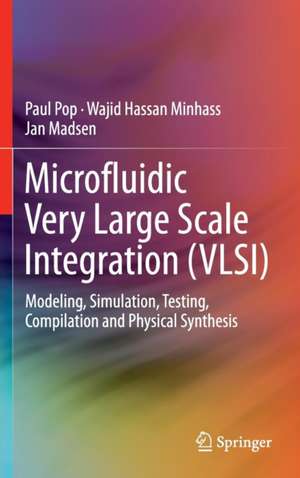Microfluidic Very Large Scale Integration (VLSI): Modeling, Simulation, Testing, Compilation and Physical Synthesis
Autor Paul Pop, Wajid Hassan Minhass, Jan Madsenen Limba Engleză Hardback – 16 feb 2016
| Toate formatele și edițiile | Preț | Express |
|---|---|---|
| Paperback (1) | 640.06 lei 6-8 săpt. | |
| Springer International Publishing – 30 mar 2018 | 640.06 lei 6-8 săpt. | |
| Hardback (1) | 646.30 lei 6-8 săpt. | |
| Springer International Publishing – 16 feb 2016 | 646.30 lei 6-8 săpt. |
Preț: 646.30 lei
Preț vechi: 760.35 lei
-15% Nou
Puncte Express: 969
Preț estimativ în valută:
123.67€ • 129.45$ • 102.93£
123.67€ • 129.45$ • 102.93£
Carte tipărită la comandă
Livrare economică 31 martie-14 aprilie
Preluare comenzi: 021 569.72.76
Specificații
ISBN-13: 9783319295978
ISBN-10: 3319295977
Pagini: 270
Ilustrații: XV, 270 p. 148 illus., 101 illus. in color.
Dimensiuni: 155 x 235 x 18 mm
Greutate: 0.58 kg
Ediția:1st ed. 2016
Editura: Springer International Publishing
Colecția Springer
Locul publicării:Cham, Switzerland
ISBN-10: 3319295977
Pagini: 270
Ilustrații: XV, 270 p. 148 illus., 101 illus. in color.
Dimensiuni: 155 x 235 x 18 mm
Greutate: 0.58 kg
Ediția:1st ed. 2016
Editura: Springer International Publishing
Colecția Springer
Locul publicării:Cham, Switzerland
Cuprins
Introduction.- Part 1. Preliminaries.- Design Methodologyfor Flow-based Microfluidic Biochips.- Biochip Architecture Model.- BiochemicalApplication Modeling.- Part 2. Compilation.- Compiling High-Level Languages.- ApplicationMapping and Simulation.- Control Synthesis and Pin-Count Minimization.- Part 3.Physical Design.- Allocation and Schematic Design.- Placement and Routing.- On-ChipControl Synthesis.- Testing and Fault-Tolerant Design.
Notă biografică
Paul Pop is a professor at DTU Compute, Technical Universityof Denmark (DTU). He has received his Ph.D. degree in computer systems fromLinkoping University in 2003. His main research interests are in the area ofsystem-level design of embedded systems. He has published extensively in thisarea, and has received the best paper award at the DATE 2005, RTiS 2007, CASES2009 and MECO 2013 conferences and the EDAA Outstanding Dissertations Award(co-supervisor) in 2011. Since 2008 he has also addressed Computer-Aided Designmethods for biochips. His work in this area has received the best paper awardat the CASES 2009 conference. He has co-organized and participated in tutorialsand special sessions on CAD for biochips at conferences such as SOCC 2011,ESWEEK 2011, EMBC 2015 and ETS 2015.
Textul de pe ultima copertă
This bookpresents the state-of-the-art techniques for the modeling, simulation, testing,compilation and physical synthesis of mVLSI biochips. The authorsdescribe a top-down modeling and synthesis methodology for the mVLSI biochips,inspired by microelectronics VLSI methodologies. They introduce a modelingframework for the components and the biochip architecture, and a high-levelmicrofluidic protocol language. Coverage includes a topology graph-based modelfor the biochip architecture, and a sequencing graph to model for biochemicalapplication, showing how the application model can be obtained from theprotocol language. The techniques described facilitate programmability andautomation, enabling developers in the emerging, large biochip market.
· Presentsthe current models used for the research on compilation and synthesistechniques of mVLSI biochips in a tutorial fashion;
· Includesa set of "benchmarks", that are presented in great detail andincludes the source code of several of the techniques presented, includingsolutions to the basic compilation and synthesis problems;
· Discussesseveral new research problems in detail, using numerous examples.
· Presentsthe current models used for the research on compilation and synthesistechniques of mVLSI biochips in a tutorial fashion;
· Includesa set of "benchmarks", that are presented in great detail andincludes the source code of several of the techniques presented, includingsolutions to the basic compilation and synthesis problems;
· Discussesseveral new research problems in detail, using numerous examples.
Caracteristici
Presents the current models used for the research on compilation and synthesis techniques of mVLSI biochips in a tutorial fashion Includes a set of "benchmarks", that are presented in great detail and includes the source code of several of the techniques presented, including solutions to the basic compilation and synthesis problems Discusses several new research problems in detail, using numerous examples Includes supplementary material: sn.pub/extras












